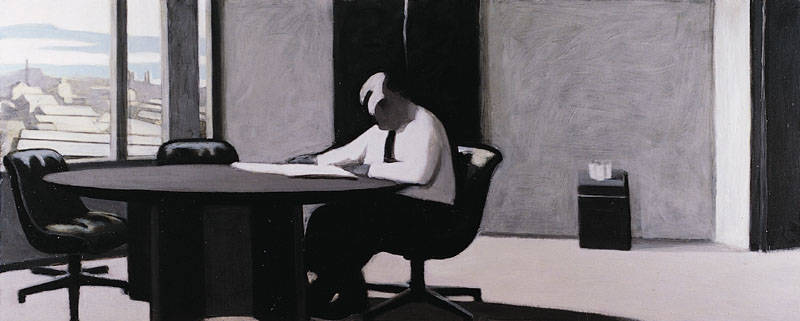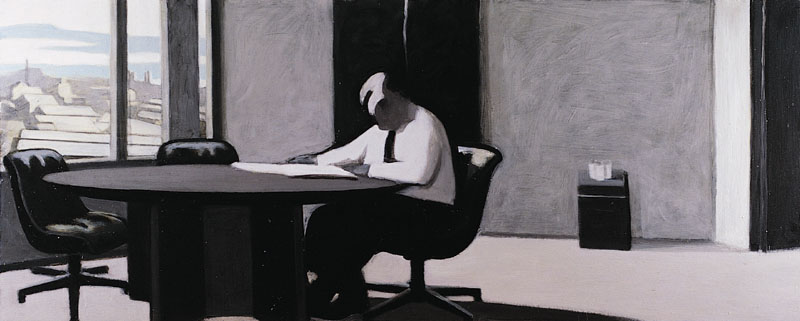MCWHANNELL, Richard;
Hugh Fletcher at Fletcher Challenge House, Penrose
1997
Oil on canvas
555 x 1370mm (support); 610 x 1415mm (frame)

This is one of three portraits commissioned on the occasion of the retirement of Hugh Fletcher, former Chief Executive of Fletcher Challenge Limited. The others are Hugh Fletcher and Lynsey Burley and Hugh Fletcher, Head Study. Behind the desk is July Waterfall by Colin McCahon.
The following text was written by Erin Griffey and Brad Jackson in response to the exhibition The Power of Portraiture, curated by Griffey.[1]
Erin Griffey and Brad Jackson
The curator of the Fletcher Trust Collection, Peter Shaw, approached the painter, who then agreed with the subject of the painting that instead of a formal sitting, the artist would observe some day to day activities that took place in his office. This was in accord with the subject’s preference for a relatively informal approach to having his portrait painted. It was one of two small-scale genre-style portraits made of him in his office, which are remarkable in commemorating leadership as both a quiet, reflective role, and one that necessitated working with others.
One [Hugh Fletcher at Fletcher Challenge House, Penrose] shows the subject’s head bent over his desk working alone, and the other [Hugh Fletcher and Lynsey Burley] depicts him standing, looking out of his office window, while his long-standing secretary, Lynsey Burley, stands behind him. The lack of superficial detail in execution and the amount of space around the two figures creates a mental weight to the picture, and the cool early morning light flooding in, rendered so realistically by McWhannell, contributes to the sense of a working, thoughtful person who is ultimately alone in being accountable to the organization that he leads.
Instead of the ancient Roman inspired convention for official portraits to focus on the subject’s face as a memorial, here Fletcher’s facial features are obscured. The focus is instead on the work setting; this is a real inhabited office rather than a portrayal of a ceremonial ‘office’ or post. The idea of representing a leader actually in the act of working, in an office as Hugh is represented, and in the transaction of working in an office, as seen here, is unique in New Zealand portraiture, and in fact highly unusual for a commissioned portrait. … Pointedly, while Fletcher’s leadership of the family business was in part his birthright, McWhannell’s images do not in any way signal dynastic claims. Removed of traditional portrait conventions, the images provide a narrative about work and leadership rather than a symbol of power.
[1] Erin Griffey and Brad Jackson, ‘The Portrait as Leader: Commissioned Portraits and the Power of Tradition’, Leadership 6, no. 2 (May 2010), 149–150.
Provenance
1997–
Fletcher Challenge Art Collection (later Fletcher Trust Collection), commissioned May 1997

